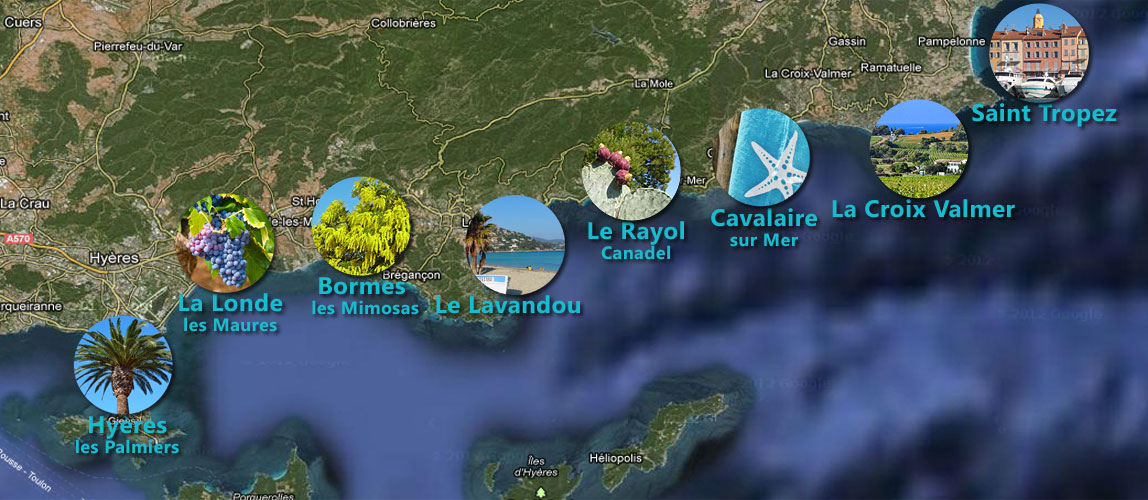Mediterranean marine animal-life

•
Sponge Verongia - Spongiaire (Verongia aerophoba)
This sponge, easy to recognize with its cylindrical masses sharp yellow, fears the air (from where its name of species aerophobia : that appears by necroses and the darkening of its fabrics. Each individual filters, to nourish itself, a hundred litres of water per day. hat appears by necroses and the darkening of its fabrics. Each individual filters, to nourish itself, a hundred litres of water per day. |
• Red Ascidie - Tunicier
(halocynthia papillosa)
It’s one of the ascidians most common. Its colouring, in spite of its name, can be also yellow or white. It measures up to 10 cm and is fixed on the rocks or in the posidoniesThis small barrel has two openings: two siphons by which the ascidia filter water to nourish itself. It is rather shade-loving: it appreciates the not very enlightened zones. |
 |
• Ortic green Sea Anemone - Cnidaire (Anemonia sulcata)
With fa-shaped padines,its green colour is due to the presence of a symbiotic alga in its fabrics.If it misses, the colour of the tentacles goes from the white to the gray. It is often in the recesses of the rocks, in water close to surface. |
• Pelagic - Jellyfish (Pélagia nocticula)
This jellyfish violet of average size is very irritating. It is phosphorescent. Sometimes it proliferates at the point to paper the sand of the beaches. That is with the combination of several positive factors to its development (temperature, currents...). |
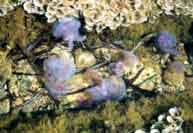 |
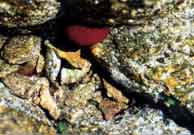 |
• Tomato of sea- Cnidaire (Actinia equina)
This sea-anemone hides in the hollows of obscure rocks. It folds up its tentacles if it is disturbed; it resembles truly a tomato then. Stages médio and supra littoral |
• Spirographe - Polychète
(Spirographis spallanzani)
This animal is an alive worm in a membranous tube. To nourish itself, it filters by its plume in spiral the suspended matter in water. It is fixed on sandy or muddy funds. One also observes it in the herbaria of phanero. |
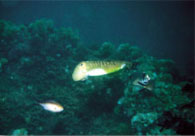 • Common Cuttlefish - Cephalopod (Sepia officinalis) • Common Cuttlefish - Cephalopod (Sepia officinalis)
It approaches the coasts during the summer. It can reach 40 cm length. It is rather a species of movable funds because it must be hiding; it often remains near the herbaria of posidonia. Its shell is internal. It is known by the owners of birds out of cage under the name “of bone of cuttlefish”; their birds find a source of limestone there. Formerly its ink was used for to write. It is also able to change colour like octopus. |
• Common Octopus - Céphalopode (Octopus vulgaris)
This cephalopod is certainly one of the most intelligent invertebrates: he is crafty one, player, curious and likes affectionate! It’s not difficult to surprise an octopus in its favourite hole.
In full day, it drives out shellfish and bivalves; one of its favourite dishes is the young elm.
The remainders of its meals in front of its hole often betray its camouflage. It changes colour according to its mood and the fill colour where it is (homochromy). Observe it, without disturbing it, you will be surprised by his behaviour. Do not kill any more the small octopuses which tame down so easily; Moreover, the octopus reduces so much to cooking |
•
Aplysie or Hare of Sea - Gastropod (Aplysia sp.)
Aplysie resembles a nudibranche (family of the slugs of sea) without shell, but it hid one well of them under its coat. One meets species of brown colour, small punctuated of white, larger being able to reach 30 cm length. Its foot adapted to the stroke; one could almost believe that it flies. |
• Black Winkle - Gastropod (Littorina nerioides)
This small gastropod grazes the cyanobacteries, primitive and microscopic algae living on the rocks. |
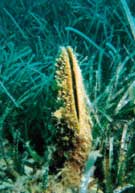 |
• Large mother-of-pearl or roughcast knuckle of ham - Mollusc (Pinna nobilis)
This protected shell can reach up to one meter length. It is inserted two thirds in sand close to the herbaria. The outside of the valves is decorated small spines in the shape of gutters. This species was collected a long time like trophy; this is why it should have been protected. Protected species. |
• Noah's Ark - Mollusc (Arca noae)
This small shell of 10 cm is lengthened. Its two valves are hung by a flat side. Often its shell is colonized by other organizations, what enables him to be dissimulated. |
• Green Chiton - Mollusc (Chiton olivaceus)
This cousin of snail protects himself thanks to eight plates limestone’s. It most frequently hides under stones. It holds company with the young elm. |
• Large hermit-crab or Pagure - Crustacean
(Dardanus arrosor)
Often it caps its shell of anemones commensalisms to discourage the predatory ones, who nourish remains of its meals. When it decides to change shell, it measures dimensions of its future house, cleans, and then moves without forgetting its invaluable anemones! It is a true symbiosis: if it is attacked the anemone (Caliactis parasitica) ejects irritant filaments, in against part it benefits from the meals of its “driver”. |
• Marbled Grapse - Crustacean (Pachygrapsus marmoratus)
This small crab likes to hide in anfractuosities of the rocks beaten by the waves. |
• Balane - Crustacean (Balanus sp.)
This small shellfish resembles a mollusc. It clings to the rocks. It is protected under plate’s limestones. It filters water using its legs to nourish plankton. Stage supra littoral. |
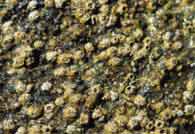 |
• Pink Shrimp - Shellfish (Paelaemon sp.)
It is pink with cooking, but in its habitat, its body is transparent with brown scratches and white points. It is necessary to be attentive to observe it on the rocks with water flower. It is détritivore: it is nourished of any organic particle passing between its grips. |
• Black Sea urchin - Echinoderm (Arbacia lixula)
Its black prickles are very sharp-edged: attention where you put the feet! Contrary to his/her edible cousin, it does not have suction cups on the back, thus it can be camouflaged with difficulty. It appreciates the rocks carrying of the algae corollaries. He also is herbivorous. |
• Sea urchin of rock or edible Sea urchin - Echinoderm (Paracentrotus lividus)
Its colour can vary the greenish one with purple while passing by the brown one. He also lives on the rock funds rich in algae which it grazes. It is able, thanks to small suction cups (podia) to decorate various remains its shell to be dissimulated. The gourmets who be mad of this iodized delight eat the genitals of the animal. |
• Purple Sea urchin - Echinoderm (Sphaerichinus granularis)
This globulous sea urchin is recognizable with its purple prickles with white points rather short. It also lives on the rock funds or in the posidonia, a little more in-depth than the two precedents. One finds it in the zones with weak current because its podia is not very effective do enable him to strongly adhere to the substrate. Its test, i.e. its shell, can measure 13 cm. |
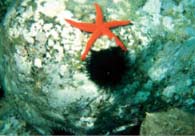 |
• Red Starfish - Echinoderm (Echinaster sepositus)
Most common of our starfishes red can turn towards the brown one or the orange one. It has five arms or more. It lives in the same mediums as her cousins the sea urchins. It seeks its food on the ground. |
• Serran - Poisson osseous (Serranus sp.)
You will cross on our coasts the Serran chevrotain (Serranus cabrilla) and the Serran writing (Serranus scriba). They are territorial fish. They often live within the herbaria; small fish nourish themselves, shellfish which they drive out with the mounting. The Serran is hermaphrodite: it is capable do fertilization its eggs. It is curious: it will come to observe you if you pass in the vicinity. |
•
Castagnole - osseous Poisson (Chromis chromis)
It swims in group above the herbaria where it nourishes zooplankton. It is recognized with its brown colour at the adult stage and with its very indented caudal fin. The youthful ones are of an electric blue. |
• Apogon - osseous Poisson
(Apogon imberbis)
This small translucent red fish elects residence in the enough deep caves or holes to be dark. The dad Apogon incubates eggs in his mouth during one week, during which it must oxygenate them. It cannot thus feed; in spite of that, it is able to be coupled, then “to brood” several times of continuation, for its period of reproduction. |
 |
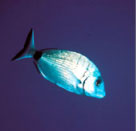 |
• Sar - Poisson osseous (Diplodus sp.)
Under the name of “Sar”, several species hide: the sar with black head, the common Sar, with pointed muzzle or large lips. It changes sex during its life. |
• Soup - osseous Poisson
(Sarpa salpa)
It grazes in bench the herbaria of posidonia. Its oval and gray body with ten gilded longitudinal lines. |
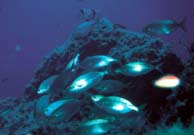 |
• Girelle Peacok - osseous Poisson (Thalassoma pavo)
This fish is the witness of the history of the Mediterranean, because it is a fish cousin of coral reefs. It is very coloured with its marbling’s and stripes turquoises on green yellow bottom. The old females can become male under the influence of the temperature. |
• Girelle - Poisson osseous - (Coris Julis)
This small fish, very common in our water, change sex during its existence. The young person is a female of small gauge, with bands of colour chestnut orange and white; then while growing its hormones change and it becomes a male, larger (25 cm), with colours glistening: it is then often called Girelle royal. One finds more females than males because they are not likely all to live enough old to change sex. |
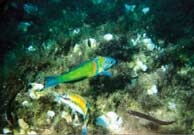 |
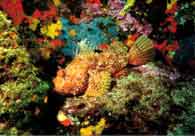 |
• Rascasse - osseous Poisson
(Scorpaena sp.)
It lives on the rocks covered with algae or in the herbaria. It drives out with the mounting. It swims little and prefers to be camouflaged on the bottom. |
• Mullet - osseous Poisson
(Mullus surmuletus)
This fish of sand-muddy funds unearths its preys in the sediment with its barbels. Its flesh is very appreciated since Antiquity. The Romans show it in a bottle to see its changes of colour in order to distract the guests from a banquet. The youthful ones, until the size of 5 cm, are bluish and live in full water. |
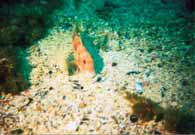 |
|
|

|
|
